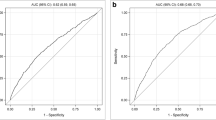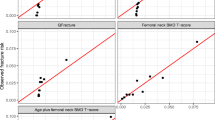Abstract
Summary
Until now there has been no published prognostic tool available for predicting of hip fracture to primary care settings. We have developed a nomogram for predicting the absolute risk of hip fracture for any individual by using clinical factors, including age, prior fracture and fall, in addition to BMD that was based on a 15-year follow-up cohort study.
Introduction
Bone mineral density or clinical risk factors alone are useful but limited tools for the identification of individuals with high-risk of hip fracture. It is hypothesized that the combination of clinical risk factors and BMD can improve the accuracy of fracture prediction. This study was aimed at developing a nomogram which combines these factors for predicting 5-year and 10-year risk of hip fracture for an individual.
Methods
The study, designed as a epidemiologic, community-based prospective study, included 1,208 women and 740 men aged 60+ years with median duration of follow-up of 13 years (inter-quartile range, IQR: 6–14) for both women and men, yielding 10,523 and 7,586 person-years of observation, respectively. Main outcome measures were incidence of hip fractures and risk factors were femoral neck bone mineral density (FNBMD), prior fracture, history of fall, postural sway and quadriceps strength. Femoral neck BMD was measured by DXA (GE-LUNAR Corp, Madison, Wisconsin, USA). Cox’s proportional hazards model was used to estimate the risk of fracture for individuals, and a nomogram was constructed for predicting hip fracture risk.
Results
Between 1989 and 2004, 127 individuals (96 women) sustained a hip fracture. Advancing age, low femoral neck BMD, prior fracture and history of falls were independent predictors of hip fracture. The area under the receiver operating characteristic curve for the model was 0.85 for both sexes. A nomogram was constructed for predicting hip fracture risk for an individual. Among those aged 75 or older with BMD T-scores ≤ −2.5, the risk of hip fracture in men was comparable to or higher than in women; however, in younger age groups, the risk was higher in women than in men.
Conclusion
The combination of BMD and non-invasive clinical risk factors in a nomogram could be useful for identifying high-risk individuals for intervention to reduce the risk of hip fracture.


Similar content being viewed by others
References
Center JR, Nguyen TV, Schneider D, Sambrook PN, Eisman JA (1999) Mortality after all major types of osteoporotic fracture in men and women: an observational study. Lancet 353:878–882
Nguyen TV, Center JR, Eisman JA (2005) Femoral neck bone loss predicts fracture risk independent of baseline BMD. J Bone Miner Res 20:1195–1201
Burger H, de Laet CE, Weel AE, Hofman A, Pols HA (1999) Added value of bone mineral density in hip fracture risk scores. Bone 25:369–374
Taylor BC, Schreiner PJ, Stone KL, Fink HA, Cummings SR, Nevitt MC, Bowman PJ, Ensrud KE (2004) Long-term prediction of incident hip fracture risk in elderly white women: study of osteoporotic fractures. J Am Geriatr Soc 52:1479–1486
Cummings SR, Nevitt MC, Browner WS, Stone K, Fox KM, Ensrud KE, Cauley J, Black D, Vogt TM (1995) Risk factors for hip fracture in white women. Study of osteoporotic fractures research group. N Engl J Med 332:767–773
Marshall D, Johnell O, Wedel H (1996) Meta-analysis of how well measures of bone mineral density predict occurrence of osteoporotic fractures. BMJ 312:1254–1259
Johnell O, Kanis JA, Oden A, Johansson H, De Laet C, Delmas P, Eisman JA, Fujiwara S, Kroger H, Mellstrom D, Meunier PJ, Melton LJ 3rd, O’Neill T, Pols H, Reeve J, Silman A, Tenenhouse A (2005) Predictive value of BMD for hip and other fractures. J Bone Miner Res 20:1185–1194
Haentjens P, Autier P, Collins J, Velkeniers B, Vanderschueren D, Boonen S (2003) Colles fracture, spine fracture, and subsequent risk of hip fracture in men and women. A meta-analysis. J Bone Joint Surg Am 85-A:1936–1943
Nguyen ND, Pongchaiyakul C, Center JR, Eisman JA, Nguyen TV (2005) Identification of high-risk individuals for hip fracture: a 14-year prospective study. J Bone Miner Res 20:1921–1928
Kanis JA, Borgstrom F, De Laet C, Johansson H, Johnell O, Jonsson B, Oden A, Zethraeus N, Pfleger B, Khaltaev N (2005) Assessment of fracture risk. Osteoporos Int 16:581–589
Sambrook PN, Seeman E, Phillips SR, Ebeling PR (2002) Preventing osteoporosis: outcomes of the Australian Fracture Prevention Summit. Med J Aust 176 Suppl:S1–S16
Kattan MW, Reuter V, Motzer RJ, Katz J, Russo P (2001) A postoperative prognostic nomogram for renal cell carcinoma. J Urol 166:63–67
Kattan MW, Zelefsky MJ, Kupelian PA, Scardino PT, Fuks Z, Leibel SA (2000) Pretreatment nomogram for predicting the outcome of three-dimensional conformal radiotherapy in prostate cancer. J Clin Oncol 18:3352–3359
Kattan MW (2003) Nomograms are superior to staging and risk grouping systems for identifying high-risk patients: preoperative application in prostate cancer. Curr Opin Urol 13:111–116
Wong SL, Kattan, MW, McMasters KM, Coit DG (2005) A nomogram that predicts the presence of sentinel node metastasis in melanoma with better discrimination than the American Joint Committee on Cancer staging system. Ann Surg Oncol 12:282–288
Jones G, Nguyen T, Sambrook PN, Kelly PJ, Gilbert C, Eisman JA (1994) Symptomatic fracture incidence in elderly men and women: the Dubbo Osteoporosis Epidemiology Study (DOES). Osteoporos Int 4:277–282
Nguyen T, Sambrook P, Kelly P, Jones G, Lord S, Freund J, Eisman J (1993) Prediction of osteoporotic fractures by postural instability and bone density. BMJ 307:1111–1115
Lord SR, Clark RD, Webster IW (1991) Postural stability and associated physiological factors in a population of aged persons. J Gerontol 46:M69–M76
Cox DR (1972) Regression models and life tables. J R Stat Soc (B) 34:187–220
Cox DR, Snell EJ (1989) Analysis of binary data. Chapman and Hall, London, UK
Hoeting JA (1999) Bayesian model averaging: a tutorial. Stat Sci 14:147–382
Raftery AE, Madigan D, Hoeting JA (1997) Bayesian model averaging dor linear regression models. J Am Stat A 92:179–191
Volinsky CT, Madigan D, Raftery AE, Kronmal RA (1997) Bayesian model averaging in proportional hazard models: assessing the risk of a stroke. Appl Statist 48:433–448
Raftery AE (1995) Bayesian model selection in social research. In: Marsden PV (ed) Sociological methodology. Blackwell, Cambridge, MA
Swets JA (1986) Form of empirical ROCs in discrimination and diagnostic tasks: implications for theory and measurement of performance. Psychol Bull 99:181–198
Swets JA (1986) Indices of discrimination or diagnostic accuracy: their ROCs and implied models. Psychol Bull 99:100–117
Swets JA (1988) Measuring the accuracy of diagnostic systems. Science 240:1285–1293
Hanley JA, McNeil BJ (1982) The meaning and use of the area under a receiver operating characteristic (ROC) curve. Radiology 143:29–36
Harrell FE Jr, Lee KL, Mark DB (1996) Multivariable prognostic models: issues in developing models, evaluating assumptions and adequacy, and measuring and reducing errors. Stat Med 15:361–387
Harrell FE Jr, Margolis PA, Gove S, Mason KE, Mulholland EK, Lehmann D, Muhe L, Gatchalian S, Eichenwald HF (1998) Development of a clinical prediction model for an ordinal outcome: the World Health Organization multicentre study of clinical signs and etiological agents of pneumonia, sepsis and meningitis in young infants. WHO/ARI Young Infant Multicentre Study Group. Stat Med 17:909–944
SAS Institute Inc. (2004) Base SAS 9.1.3 Procedures guide, volumes 1–4. SAS Publishing, Cary, NC, USA
R Development Core Team (2006) R: a language and environment for statistical computing, http://www.R-project.org. R Foundation for Statistical Computing, Vienna, Austria
Adams AM, Smith AF (2001) Risk perception and communication: recent developments and implications for anaesthesia. Anaesthesia 56:745–755
Kattan MW (2002) Nomograms. Introduction. Semin Urol Oncol 20:79–81
Kattan MW, Leung DH, Brennan MF (2002) Postoperative nomogram for 12-year sarcoma-specific death. J Clin Oncol 20:791–796
Nguyen TV, Pocock N, Eisman JA (2000) Interpretation of bone mineral density measurement and its change. J Clin Densitom 3:107–119
Kanis JA, Johnell O, De Laet C, Johansson H, Oden A, Delmas P, Eisman J, Fujiwara S, Garnero P, Kroger H, McCloskey EV, Mellstrom D, Melton LJ, Pols H, Reeve J, Silman A, Tenenhouse A (2004) A meta-analysis of previous fracture and subsequent fracture risk. Bone 35:375–382
Grisso JA, Kelsey JL, O’Brien LA, Miles CG, Sidney S, Maislin G, LaPann K, Moritz D, Peters B (1997) Risk factors for hip fracture in men. Hip Fracture Study Group. Am J Epidemiol 145:786–793
Raisz LG (2005) Pathogenesis of osteoporosis: concepts, conflicts, and prospects. J Clin Invest 115:3318–3325
Acknowledgments
We gratefully acknowledge the assistance of Sr. Janet Watters, Donna Reeves, Shaye Field and Jodie Rattey for the interview, data collection and measurement bone mineral density. We also appreciate the invaluable help of the staff of Dubbo Base Hospital. We thank Mr David Hayes and the IT group of the Garvan Institute of Medical Research for the management of the database. This work has been supported by the National Health and Medical Research Council of Australia, and untied educational grants from GE-Lunar, Merck Australia, Eli Lilly International and Aventis Australia. The first author is a recipient of the postgraduate Research Award from the National Health and Medical Research Council of Australia. TV. Nguyen and JR Center are supported by the Australian National Health and Medical Research Council.
Conflict of interest statement
Dr Eisman received funding and servers as a consultant for Aventis, Eli Lilly and Company, MSD, NPS Pharmaceuticals, Novartis, Oragon, Roche and Servier. All other authors have no conflict of interest.
Author information
Authors and Affiliations
Corresponding author
Additional information
Source of financial support: National Health and Medical Research Council, Australia
Rights and permissions
About this article
Cite this article
Nguyen, N.D., Frost, S.A., Center, J.R. et al. Development of a nomogram for individualizing hip fracture risk in men and women. Osteoporos Int 18, 1109–1117 (2007). https://doi.org/10.1007/s00198-007-0362-8
Received:
Accepted:
Published:
Issue Date:
DOI: https://doi.org/10.1007/s00198-007-0362-8




